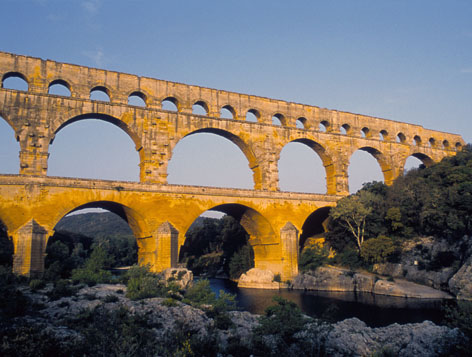PONT DU GARD
Department: Gard
Region: Languedoc-Roussillon
A SPECTACLE OF ANTIQUITY AND INGENUITY
The Pont du Gard is a vast Roman aqueduct bridge that crosses the Gard River. It is part of a 50km (31 miles) long aqueduct that runs between Uzès and Nîmes and is located in Vers-Pont-du-Gard, near Remoulins, in the Gard département.
The aqueduct was constructed in the 1st century AD and is the highest of all Roman aqueduct bridges and the best preserved after the Aqueduct of Segovia. It was added to UNESCO's list of World Heritage Sites in 1985.

© ATOUT FRANCE/Jean François Tripelon-Jarry
© ATOUT FRANCE/Pascal Gréboval
The bridge has three tiers of arches, standing 48.8m (160 ft) high. The whole aqueduct descends in height by only 17m (56 ft) over its entire length, while the bridge descends by a mere 2.5cm, indicative of the great precision that Roman engineers were able to achieve using only simple technology. The aqueduct formerly carried an estimated 200 million litres (44 million gallons) of water a day to the fountains, baths and homes of the citizens of Nîmes. It was possibly in use until as late as the 9th century, well after the fall of Rome.
The Pont du Gard's subsidiary function as a toll bridge ensured its survival in the Middle Ages. It attracted increasing fame from the 18th century onwards and became an important tourist destination, undergoing a series of renovations that culminated in 2000 with the opening of a new visitor centre and the removal of traffic and buildings from the bridge and the area immediately around it. Today it is one of France's most popular tourist attractions.
© ATOUT FRANCE/Daniel Philippe
In days gone by you could walk across the very top, but that was highly dangerous, and is now forbidden. But that doesn't mean that you can't get an awe-inspiring vision of this colossus of ancient Rome.
The main interpretation centre (Pont d'Accueil) tells the whole story, and you need to devote at least half a day to the visit.
The multimedia exhibition plunges you back in time - The museum embraces the history of the Pont du Gard and the Roman aqueduct of Nîmes” which it covers, in three sections: the Roman civilisation: why and how the Romans built the aqueduct: the life of the Pont du Gard and how it has been represented through the centuries.-
Since 2003, the visitor is also invited to experience the Mémoires de Garrigue, a mosaic of cultivated plots, signposted with stones (Petit Poucet) and surveyor’s marks that tells the stories of cereals, vineyard, olive trees and married cultures, green oaks, useful plants, fauna and flora.
SEARCH THIS WEBSITE

VISITOR INFORMATION
Pont du Gard
Tourist Office (Remoulins Office)
Place des Grands
Jours, 30210 REMOULINS
Tel: 04 66 37 22
34
www.pontdugard-tourisme.com
The Pont du Gard site is open all year round. The shops and discovery
areas are open every day from 0900 until 1900 (Jun and Sep), 2000 (Jul-Aug),
1700 (Nov-Feb), 1800 (Mar-May and Oct). A charge of €18 is made per vehicle,
giving access to the entire site.
If you plan on making more than one visit, then opt for the annual pass (carte d'abonnement annuel), €25.
VIEW MAP
of Pont du Gard area
